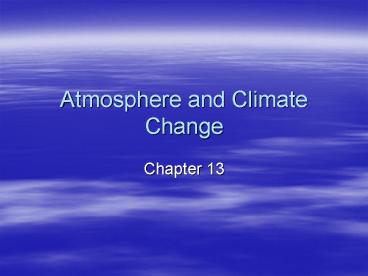Atmosphere and Climate Change - PowerPoint PPT Presentation
1 / 27
Title: Atmosphere and Climate Change
1
Atmosphere and Climate Change
- Chapter 13
2
Climate and Climate Change
- Climate- long term prevailing weather conditions
in a particular place - Factors that influence climate
- Latitude
- Atmospheric circulation patterns
- Oceanic circulation patterns
- Local geography
- Solar activity
- Volcanic activity
3
Climate and climate change
- Latitude- distance north or south of the equator
- Low latitudes- 12 hours of sun light, high
temperatures year around, no seasons - High latitudes- sun light varies between summer
and winter months, lower temperature than areas
near the equator
4
Climate and Climate Change
- Atmospheric circulation-
- Cold air sinks
- Warm air rises
- Warm air holds more moisture than cold air
- Sun light shines on the ground and warms the air
above it. The warm air rises and cooler air
moves in to fill its place. This causes wind. - The uneven heating of the earths surface and the
spin of the earth causes prevailing winds.
5
Climate and Climate Change
6
Climate and Climate Change
- Oceanic circulation patterns
- Surface currents are mainly affected by
prevailing winds - El Nino- short term (6-18 months), warm water is
pushed east, causes increased rainfall in the
southern US and central America, causes drought
in Indonesia and Australia - La Nina- cooler than normal water- opposite
effects to El Nino
7
Climate and Climate Change
- Ocean Circulation Patterns
- Pacific Decadal Oscillation- long term (20-30
year cycle), affects climate over North America,
affects surface water temperatures, air
temperatures, and precipitation patterns.
8
Climate and Climate Change
- Topography-
- Elevation- temperature drops 6 C for every 1000
ft - Mountains can affect precipitation
- Sun
- Solar maximum- increased amounts of UV radiation
can increase stratospheric temperatures as well
as lower atmospheric temperature. - Volcanic eruptions
- Sulfur dioxide emitted from a volcano can reach
the upper atmosphere and react with water vapor
and dust to form a bright haze. This haze
reflects sunlight back into space cooling the
earth.
9
Climate and Climate Change
10
Climate and Climate Change
- Seasonal Changes in Climate
- Earths axis is tilted at 23.5
- Summer northern hemisphere leans toward the sun
- Winter southern hemisphere leans toward the sun
11
Climate and Climate Change
12
Climate and Climate Change
13
The Ozone Shield
- Ozone layer- an area of the stratosphere where
ozone is highly concentrated - Ozone a molecule made of 3 oxygen atoms
- Absorbs most of the UV light that reaches the
earth from the sun
14
The Ozone Shield
- Ozone depletion-
- Chlorofluorocarbons (CFCs)- a class of
human-made chemicals that might damage ozone - Nonpoisonous, nonflammable, non-corrosive
- Used as..
- coolant in refrigerators
- To make foam
- Spray propellant
- Chemically stable at earths surface
- Over a 20-30 year period CFCs make there way to
the upper atmosphere.
15
The Ozone Shield
16
The Ozone Shield
- Scientist have estimated that a single chlorine
atom can destroy 100,000 ozone molecules.
17
The Ozone Shield
- Thinning of the ozone layer was reported in 1985
(50-98) around Antarctica. - Polar stratospheric clouds form causing CFCs to
breakdown to Cl. The Cl reacts with the ozone in
the presence of UV light. - UV light kills living cells
18
The Ozone Shield
19
The Ozone Shield
- 1987 Montreal Protocol- a group of nations agreed
to decrease the production of CFCs - 1992- developed nations agreed to ban the use and
production of CFCs
20
Global Warming
- Greenhouse effect- process of heat absorption by
gasses in the earths atmosphere - Greenhouse gases
- Water vapor
- Carbon dioxide
- CFCs
- Methane
- Nitrous oxide
21
Global Warming
- Most scientist think that increased levels of
greenhouse gases will cause increases in global
atmospheric temperature, but not all scientist
agree. - Global CO2 levels fluctuate throughout the year
(high in winter and low in summer)
22
Global Warming
23
Global Warming
- Some scientist believe that the warming trend
that started at the beginning of the 20th century
will continue. Other believe that the warming
trend is part of a natural occurrence of
fluctuating temperatures that appear throughout
time.
24
Global Warming
- The Consequences
- Melting ice and rising sea level
- Weather pattern changes
- Stronger hurricanes and typhoons
- Change in precipitation patterns
- Human health problems
- Heat related deaths
- Increase in ground level ozone causing reparatory
disease - Increase in disease carrying insects
25
Global Warming
- Consequences- cont
- Agriculture
- Droughts
- Diseased crop yields may increase
- Effects on plants and animals
- Alter habitat ranges
- Alter available food sources (zooplankton)
26
Global Warming
- Recent findings- IPCC
- Third Assessment Report
- Average global temperature increased 0.6 C during
20th century - Snow cover and ice extent decreased
- Global sea level has risen
- Increase in greenhouse gases due to human
activities
27
Global Warming
- Reducing Risk
- Kyoto Protocol (1997)
- 55 of nations ratify
- Developed nations decrease emissions by 5 below
their 1990 levels by 2012































